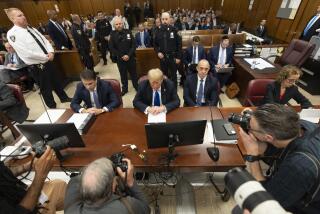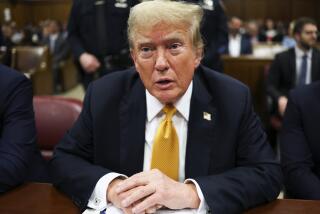Diverse Group of Jurors Deciding Stewart’s Fate
- Share via
NEW YORK — After 27 witnesses and 19 days of testimony and arguments, the jury is officially out on Martha Stewart.
The panel -- as diverse as New York -- includes a Uganda-born pharmacist, a clergywoman, an Italian-language interpreter and a man whose regular poker game includes Wall Street pros: stockbrokers and “hedge fund people.”
The eight women and four men began deliberations Wednesday after U.S. District Judge Miriam Goldman Cedarbaum gave them 90 minutes of legal instructions on the revised, eight-count indictment facing Stewart, 62, and her ex-stockbroker, Peter E. Bacanovic, 41.
The charges at issue -- including conspiracy, obstruction of justice and lying to federal investigators -- stem from Stewart’s Dec. 27, 2001, sale of $228,000 worth of ImClone Systems Inc. stock. The trade came after Bacanovic allegedly had his assistant pass Stewart a tip that ImClone founder Samuel D. Waksal was trying to unload his stock.
The jury deliberated for four hours Wednesday afternoon and retired without reaching a verdict. The jurors sent out two notes requesting charts and transcripts of testimony. Some of the material was still being prepared for them when they called it quits for the day.
One request was for charts of phone calls on the day of the ImClone trade among Stewart, Bacanovic and his then-aide at Merrill Lynch & Co., chief prosecution witness Douglas Faneuil. The jury also sought transcripts of Faneuil’s testimony about those phone calls.
A later request seemed to focus on charges that Bacanovic lied in a conversation with federal investigators by saying it was he, not Faneuil, who actually handled Stewart’s ImClone trade. The jury asked to see transcripts of testimony from an FBI agent and a Securities and Exchange Commission lawyer who participated in the questioning.
They also seemed to be pondering the conspiracy charge, seeking records relating to how many times Stewart and Bacanovic spoke between the day of the trade and Feb. 4, 2002, when Stewart gave her first interview to federal authorities. Prosecutors allege that they communicated to concoct a story to hide the reasons for her stock sale.
Before beginning its deliberations, the jurors made an unusual request: Could they first have lunch with the six alternate jurors who had sat with them through the trial but now were being sent home?
“I think the jurors have bonded,” Cedarbaum remarked, granting their wish.
Not everyone was thrilled to be on the panel. One woman tried to beg off because her publishing job required a lot of travel and she didn’t want to put off her trips for five weeks or more. Another juror had to forfeit a $1,200 vacation package to Puerto Rico with his girlfriend.
The jurors will remain anonymous until their verdict is announced and Cedarbaum polls each by name. What is known about them now is based on physical observations during the trial and edited transcripts of their interviews with defense and prosecution lawyers during jury selection in January.
Here are capsule sketches of the people who, in the words of defense lawyer Robert G. Morvillo, hold Stewart’s life in their hands:
Juror No. 1 (the forewoman): a white woman in her 40s with short, blond, swept-back hair and glasses who favors turtleneck jerseys and fleece vests. She said she was “very familiar” with the name Martha Stewart.
Juror No. 2: an African American woman in her 30s, fashionable, who likes knit scarves and sweaters. She said the only thing that might make such a trial difficult for her was “that I am not familiar with corporate dialect.”
Juror No. 3: a white or Latino man in his 30s, trim and plainly dressed, with a beard and glasses. He’s the poker player who had to cancel his Puerto Rico trip. Although he didn’t name his profession, he said he had “a rather large responsibility” in his industry. One of the funds he invested in lost 20% “due to the antics that were going on” with Enron Corp. and “the dot-coms that fell through.”
Juror No. 4: a white man in his late 40s or early 50s with short white hair, a beard and bushy eyebrows, often dressed in bulky sweaters. He laughs easily. He said he read something about Stewart and Bacanovic “like a year ago. But I forgot what it was about.”
Juror No. 5: a white woman in her 50s, with dark hair and glasses on a chain. She is a member of an Art Directors Club in New York that once hosted a talk by an executive in Martha Stewart’s media company. She said she thought “sometimes people are incarcerated that shouldn’t be” and that it “happens more often with poor people.” She also said she wished the prosecution of people involved in corporate scandals “was moving along a little faster.”
Juror No. 6: a white woman in her 60s, stylishly coiffed and favoring skirt-and-jacket ensembles. She had asked to be excused from the trial because of job-related travel responsibilities. She once met Internet analyst Mary Meeker -- identified before the trial as a potential government witness -- through her husband, a former Wall Street Journal reporter who specialized in venture capital. She doesn’t blame her broker when an investment goes bad. “Those are our gains or our mistakes,” she said.
Juror No. 7: a white woman in her late 20s or early 30s with long blond hair and fashionable, casual clothes. She saw part of Stewart’s interview with CNN’s Larry King in which she proclaimed her innocence.
Juror No. 8: an African American man in his 30s, burly with glasses and a goatee. He is a communications technician who formerly worked for the Wall Street brokerage firm of Shearson Loeb Rhoades. He said he may have seen stories about Martha Stewart while channel surfing, but he added that he moved on because “it is not anything that is of interest to me.”
Juror No. 9: a white man in his late 30s, tall, dressed neatly but often in jeans. He works as a paralegal and an interpreter of Italian. His paralegal work has included record-industry cases involving copyright infringement. He has read about Stewart but said: “I tend to read everything with a grain of salt and I tend to look at everything recognizing the prejudices of the source.”
Juror No. 10: an African American woman in her late 30s or early 40s, heavyset with short hair swept forward dramatically and partial to colorful scarves. She said her best friend once worked at Merrill Lynch. She once sued a dry cleaner for staining an antique dress she had received as a gift from a relative.
Juror No. 11: an African-American woman in her 30s with glasses who wears flowing, colorful dresses. She described herself as “a reverend” who sometimes acts as a marriage counselor and as a result is “aware that there are two sides to everything.” She also works for a law firm that represents insurance claimants.
Juror No. 12: a dark-skinned, possibly Indian, woman in her 50s, who wears sweaters or turtlenecks and glasses. She is a pharmacist born in Uganda and raised there and in India. She speaks at least three languages, but Morvillo challenged her during jury selection because he thought her English was poor.
More to Read
Sign up for Essential California
The most important California stories and recommendations in your inbox every morning.
You may occasionally receive promotional content from the Los Angeles Times.













